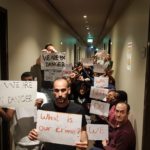The Indefinite Detention Achilles Heel: An Interview With Human Rights For All’s Alison Battisson

The Magna Carta is a charter of rights that was drafted by the court of King John of England in 1215. And to this day, the eight-century-old document provides the foundational legal principles of our modern Australian democracy, including that of habeas corpus.
Also known as the great writ, habeas corpus is the right to call on a court to deliberate upon whether the incarceration of an individual is justified. Invoking the principle requires a detaining authority to bring its detainee before the court to determine the legality of their imprisonment.
“Habeas corpus is the remedy by which representatives of the state are brought to account for their detention of the individual,” former Federal Court Justice Kevin Lindgren said in 2013, adding that the UK Habeas Corpus Amendment Act 1679 ensured that undermining this right is unlawful.
To put some perspective on how this 805-year-old recourse in law is still holding its own, a legal firm invoked the principle during a Federal Court case in September, which not only saw a long-term detainee released, but it also exposed a chink in the government’s indefinite detention regime.
An Australian legal first
Human Rights for All represented a 29-year-old Syrian man referred to as AJL20 in Federal Court proceedings last July, which saw the long-term resident, who first came to Australia as a child, released into the community after being held in immigration detention for six long years.
The pro bono law firm argued that under the Migration Act 1958 (Cth), a detainee must be held for a purpose. In AJL20’s case this was deportation on character grounds. And its required that this deportation happens “as soon as reasonably practicable”, regardless of any danger involved in repatriation.
However, its government policy to follow the international principle of non-refoulement, which involves not transferring people from its jurisdiction to another where there’s a risk of irreparable harm.
So, following a request to return AJL20 to Syria. It became obvious he wasn’t being detained to be returned to the war-torn region as soon as possible.
“I have concluded that, since 26 July 2019, the applicant’s detention by the Commonwealth has been unlawful,” ruled Justice Mordecai Bromberg on 11 September 2020. “I will make an order directed to the Commonwealth commanding it to release the applicant from detention forthwith.”
The precedent set by AJL20 versus Commonwealth of Australia is now beginning to impact upon practices that the federal government has long been meting out to asylum seekers and refugees who’ve broken no laws, as well as long-term residents who’ve already served their time.
Unlawful legal limbo
Director principal of Human Rights for All Alison Battisson told Radio New Zealand just after the court had made its determination that “anyone who is in detention and nothing has happened on their case for a significant period of time should be looking at this judgement”.
And that’s exactly what’s happened. In the second week of December, five of the former offshore asylum-seeking detainees brought to Australia under the now-revoked Medevac laws – who’ve been locked up in hotels since arrival – were released into the community as a direct result of AJL20.
Sydney Criminal Lawyers spoke to Alison Battisson about what she argued to see her client released into the community, his legal status at present, and why the solicitor believes the government ought to come to grips with the determination and release those being detained in unlawful legal limbo.

Firstly, in September last year, the Federal Court made a landmark ruling when deciding to release AJL20 from ongoing detention after six years based on your habeas corpus argument.
Ms Battisson, what did you actually argue? And why did it get over the line?
We had two arguments. One was to do with backward-looking unlawful detention, meaning that from a particular point in time, when nothing external had been happening in the AJL20 case, from that moment onwards his detention was unlawful.
What that meant was the department or the minister couldn’t cure the legality of the detention. What had happened previously when we tried to run a habeas argument was, as soon as we filed it, the government then started doing something to justify the person’s detention.
We thought, right, we’ll take a backward-looking approach, and at the same time, have this habeas element added to it.
We were very confident that the court would find a certain period of time had been unlawful – approximately 18 months.
We were less confident – and became even less confident as it took longer and longer for the decision to be handed down – that we would win on the habeas argument.
But we did. It was effectively because the court recognised that a person needs to be detained for a purpose, and that purpose must be admittance into Australia or removal from Australia. And in addition, the detaining authority must pursue that purpose.
So, you can’t just warehouse someone, which was the situation in this case. He was just left to rot.
Your client isn’t the only immigration detainee to have been placed in indefinite detention. There are many being held under such circumstances right now.
How can the Australian government simply leave people languishing in these centres like this?
Until now, the state of the law has effectively allowed indefinite detention.
The blinking at the beast was that there was a risk that the government might say, “All right, you’re complaining about your indefinite detention, so we’ll send you home. We will send you back to Syria.”
So, we had to get our client very comfortable with that risk. It was a small risk. But it was there. And no one had really run it like that beforehand.
We didn’t ask for mandamus to force the minister to send him back, because he’d had the chance.
What we said was that we seek damages for unlawful detention and release, because there’s no purpose to this person’s detention, and under the Migration Act, there must be a purpose.
And I believe that AJL20 has been released into the community under some peculiar circumstances?
AJL20 was released on an order of the court, which is the habeas corpus part. So, he is in the community without a visa, and he is not a citizen.
He is in this very legally interesting situation, which the government was trying to avoid.
You’re the director principal of Human Rights for All. It provides legal assistance to refugees and stateless people in obtaining visas.
Can you tell us more about the work your organisation performs?
We’re a pro bono law firm. We specialise in immigration detention for the hard cases: stateless people, and refugees and asylum seekers who have been in detention for half a decade to a decade.
These are cases that everyone else has effectively given up on. And they’re the ones that we want, so as to really test the law of indefinite detention in Australia against international standards and our own domestic law.
That’s what we specialise in, and we do it through a human rights framework. So, instead of looking at immigration law or visas, we look at it through breaches of human rights.
We do a huge amount of work with the United Nations, the Australian Human Rights Commission and other human rights focused bodies.
And lastly, the government is set to appeal the AJL20 decision in the High Court this April. However, refugees are already being released under the precedent the case has set.
There are also concerns amongst refugee advocates that the Medevac detainees could be sent to Christmas Island around the same time as the appeal.
Ms Battisson, what are you expecting to happen moving into the new year in regard to the government’s ongoing and drawn out detention of these people?
What I expect to happen, and what I hope will happen are two different things. AJL20 is good law, as it hasn’t been overturned. So, I would hope that the Australian government takes a sensible human rights and economic approach.
That would mean recognising that the state of the law as it is today is that anyone in immigration or administrative detention who’s there for the purpose of removal, and that purpose hasn’t been pursued, then their detention is unlawful and they must be released.
I would hope for the release of all the Medevac people and others in immigration detention who are there unlawfully.
We’ve filed ten similar cases that we’re pushing through the courts as fast as we can. And there are other lawyers and law firms doing exactly the same.
My hope is that the government will take the sensible approach and release the people who are unlawfully detained, because, ultimately, these are damage claims as well.
So, with AJL20, we know who is liable for his detention. There is a separate question that’s being appealed, but at some point, the quantum of the damages will need to be determined.
So, how much money is he going to get? And how much money are all these other people going to get?
How much is a day, a week, a month or a year of a life worth?







